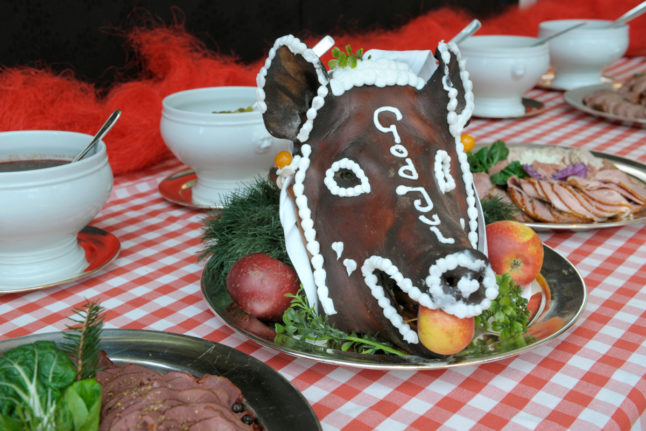Here are six weird Swedish Christmas foods to look out for in the coming days…
1. Lutefisk
This slimy looking white stuff is a Swedish Christmas classic, and if slimy sounds bad enough in itself, then Lutefisk, or Lutfisk in Swedish, can be even harder to stomach once you know how it’s prepared.
You won’t find this at every Christmas meal, but the ones who do serve it will never be convinced of doing otherwise.
The dish is made by treating dried whitefish in lye for a period of days, which gives it its strange jelly-like texture. For those unaware what lye is, the Oxford English dictionary defines the substance as “a strongly alkaline solution, especially of potassium hydroxide, used for washing or cleansing”.
Yes, that’s right, some Swedes love nothing more at Christmas than to tuck into fish stewed in stuff that is also used in, among other things, soap making, oven cleaners and even getting rid of human bodies. Mmm, tasty.
2. Egg cheese
If you’re lucky enough to have friends or relatives from Bohuslän in the west of Sweden, you may find yourself presented with something called äggost this Christmas, which translated to English means “egg cheese”.
Along with being a brilliant example of how Sweden loves to take the literal approach to naming things, like Lutefisk, it’s a remnant from the days when Swedes had to come up with creative methods of storing food before the luxury of refrigerators existed.
The dish is made from combining curdled milk with eggs, then setting the mixture in a mold just like jelly, and it ends up with a similar texture too. Once it’s nice and wobbly, it can be served with either herring or jam, according to taste.
3. Dip in the pot
No, this isn’t something that happens when a bad Christmas meal provokes an upset stomach. Rather, dip in the pot or dunk in the stew (dopp i grytan) is a way of making the most of the Swedish Christmas ham by dipping bread into the reduced broth that the pork was cooked in.
It’s also one further reminder of the aforementioned Swedish habit of naming things very, very literally.
4. Mumma
The name of this heavy Christmas drink resembles a word in Swedish that is something like the English “yummy” (mums), and while we can’t verify if that’s the case, we can verify that it’s not for the faint-hearted. The drink typically contains no less than four kinds of alcohol (porter, lager, gin and port) to create an odd sort of Christmas cocktail.
Mumma first rose to prominence in Sweden during the 1500s, then experienced a renaissance in the 1900s, and though it’s not universally popular today, ready-made versions can still be bought at state-owned alcohol monopoly Systembolaget.
Anyone outside of Sweden keen to try making some can throw together a rough and ready version by combining a cup of porter, a cup of lager, and a cup of soda with four centilitres of gin and four centilitres of port. That’s enough to make a litre, so go easy on it!
5. Ris à la Malta
Admittedly, this Swedish Christmas dessert isn’t necessarily weird because of its contents, but it is weird in name. Many an innocent international will have heard the French-sounding “ris à la Malta” and presumed the dish is exactly what it claims to be: rice, Maltese style.
In fact, it’s zero percent Maltese, and rather hails from far closer to home. The Swedish name for the originally Danish dish is thought to be a phonetic corruption of the Danish name Risalamande.
Along with providing yet more proof of how much of a tough time the Swedes have understanding their southern neighbours, the name has served the purpose of confusing trusting foreigners for years.
In case you’re wondering, it’s basically rice pudding.
6. A smoked pig’s head
Though increasingly a dying tradition, it’s still possible to find a smoked pigs head at some Swedish Christmas meals, and the accompanying tradition of decorating it and even writing a cheery Christmas message on the snout says something about the dark side to Swedish humour.
Swedish meat industry organisation Svenskt kött says a pig’s head in the middle of the Julbord is an “amazing sight”, and while we’ll leave that for you to decide, it’s certainly likely to provoke an opinion, one way or another.
Oh, and if you’re really lucky, you may also be treated to jellied grisfötter – pig’s trotters – too.
Article written by Lee Roden in 2016 and updated in 2023.



 Please whitelist us to continue reading.
Please whitelist us to continue reading.
Member comments